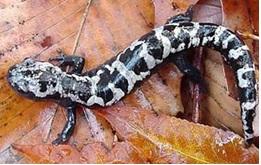Vernal Pools & Big Night

"Big Night" is coming! What's a big night? On the first rainy spring evening(s) where temps are around 40-50 degrees, amphibians emerge from hibernation and head to vernal pools, wetlands, and ponds to breed. During this time hundreds can cross the road, or even thousands depending on the habitat. These sleepy frogs and salamanders head to the closest wetland, pond, or vernal pool to breed, and often this now means crossing roads. Big Night is our chance to not only see these special and secretive species that are the life force of our upland forests, but to help them safely across the road.
Helping amphibians means helping ourselves as frogs and salamanders are voracious insect eaters at both stages of their lives. Though small, spotted salamanders and other species can live to be up to 20 years old! Here are some hot spots in Nottingham where frogs and salamanders could especially use help crossing roads on the first rainy ~50 degree nights this spring, but any spot in town with forested wetlands/ vernal pools flanking the roads are possibilities.
Berry Road, Freeman Hall, Steven's Hill, Cooper Hill, Garland Road, Flutter Street, Kelsey Road, Case Road
The 2018 Big Night Crossing Brigades Handbook is a great resource for what to expect, how to stay safe, species identification, and how to record and report amphibians you have found from the Harris Conservation Center. We would love to see photos and identify species of frogs and salamanders you move this year, please feel free to post them on the Nottingham Conservation Commission Facebook page, or email us at NottCC2014@gmail.com.
The Nottingham Conservation Commission is a volunteer-run, Board of Selectman appointed committee. The mission of the NCC is to collaborate with local and regional boards and organizations to inventory, map, and protect Nottingham’s natural resources and open space. The Center for Wildlife is a 501c3 non-profit with a mission to sustain local wildlife through their medical clinic, education, and research activities. Learn more about their efforts at The Center for Wildlife.
| Attachment | Size |
|---|---|
| 6.36 MB | |
| 3.09 MB | |
| 5.65 MB | |
| 2.81 MB | |
| 60.33 KB |

